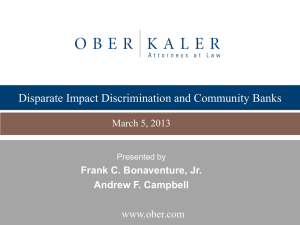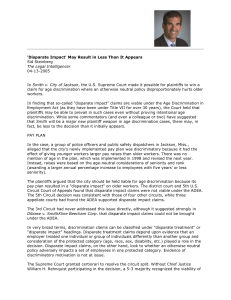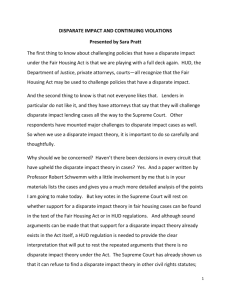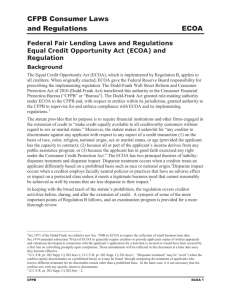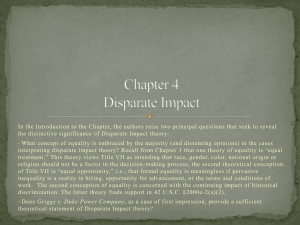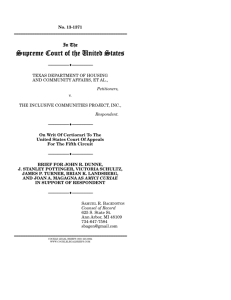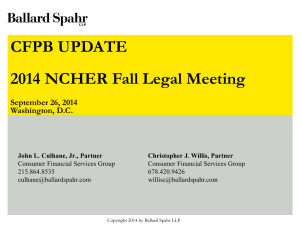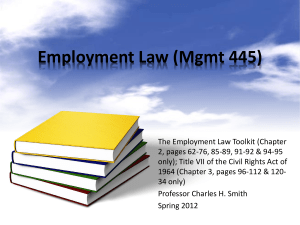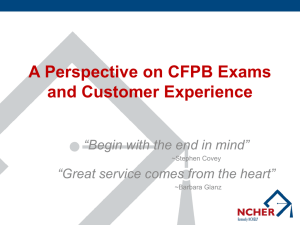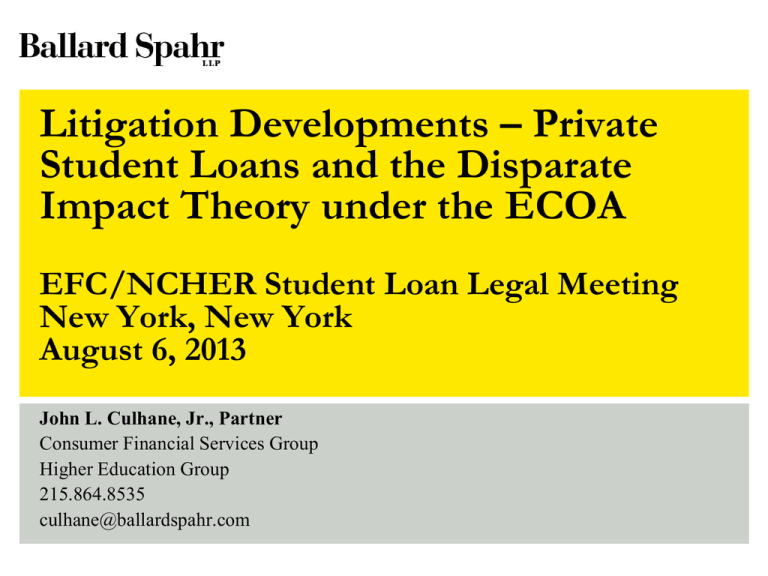
Litigation Developments – Private
Student Loans and the Disparate
Impact Theory under the ECOA
EFC/NCHER Student Loan Legal Meeting
New York, New York
August 6, 2013
John L. Culhane, Jr., Partner
Consumer Financial Services Group
Higher Education Group
215.864.8535
culhane@ballardspahr.com
Private Student Loans – The Focus
•
School eligibility determinations
•
Borrower eligibility determinations
•
Pricing tiers using factors that have a disparate impact
•
Discretion with borrower benefits and loss mitigation
policies
•
E.g., CFPB Private Student Loan Report (use of federal
cohort default rate (“CDR”), graduation rate, or any other
school-specific criterion); CFPB First Annual Fair
Lending Report (use of CDR); major bank lenders have
since undergone exams but no further public actions
2
Disparate Impact – Statutory Text
Statute
Title VII
ECOA
Fair Housing
Act
Disparate
Treatment
Prohibition
It shall be an unlawful employment
practice for an employer … to fail
or refuse to hire or to discharge any
individual, or otherwise to
discriminate against any individual
…. because of such individual’s
race, color, religion, sex, or
national origin
(§ 703(a)(1))
It shall be unlawful for any
creditor to discriminate against
any applicant, with respect to any
aspect of a credit transaction …
on the basis of race, color,
religion, national origin, sex or
marital status, or age
[I]t shall be unlawful … [t]o
refuse to sell or rent after the
making of a bona fide offer,
or to refuse to negotiate for
the sale or rental of, or
otherwise make unavailable
or deny, a dwelling to any
person because of race, color,
religion, sex, familial status,
or national origin.
(§ 804(a))
to limit, segregate, or classify his
employees … in any way which
would deprive or tend to deprive
any individual of employment
opportunities or otherwise
adversely affect his status as an
employee, because of such
individual’s race, color, religion,
sex, or national origin
(§ 703(a)(2))
None
Disparate
Impact
Prohibition
(§ 701(a)(1))
None
Adapted from Peter Cubita and Michelle Hartmann, The ECOA Discrimination Proscription and Disparate Impact – Interpreting the Meaning3 of
the Words That Actually Are There, 61 The Business Lawyer 831 (2006).
Disparate Impact – ECOA – Deference?
•
Interpretation of ECOA text or legislative history?
•
Footnote 2 to Section 1002.6(a) of Regulation B (the
legislative history indicates that Congress intended an
“effects text” concept”)
•
Comment 1002.6-2 of the Official Staff Commentary
(“Congressional intent ...is documented in [Senate Report
No. 94-589] and in [House Report No. 94-210]”)
•
The 1994 Interagency Policy Statement, 59 Fed. Reg.
18266 (Apr. 15, 1994) (adopted by HUD, DOJ, OCC,
OTS, FRB, FDIC, FHFB, FTC, NCUA and OFHEO)
4
Disparate Impact – FHA – Deference?
•
Interpretation of FHA text or legislative history?
•
HUD rulemaking proceeding ostensibly to formalize its
“long-standing interpretation”
•
Proposed rule issued with 60-day comment period, 76 Fed.
Reg. 70921-27 (Nov. 16, 2011)
•
Final rule, issued 30 days after end of comment period,
adopted disparate impact standard, with some minor
changes, 78 Fed. Reg. 11460-82 (Feb. 15, 2012)
•
Final rule, at 24 C.F.R. §§ 100.5 et seq., took effect on
March 18, 2013
5
Disparate Impact – The CFPB
•
Bulletin No. 2012-04, issued April 18, 2012 (“the legal
doctrine of disparate impact remains applicable”)
•
First Annual Fair Lending Report, released December of
2012 (citations to CFPB Bulletin No. 2012-04 and the
Private Student Loan Report’s criticism of CDR)
•
Bulletin No. 2013-02, issued March 21, 2013 (application
of doctrine to dealer rate participations)
•
ECOA Baseline Review Modules, released July 2013
(numerous references to disparate impact – but oddly, no
separate module for private student loans)
6
Disparate Impact – Mount Holly Case
• Cert granted, on June 17, 2013, on question 1, which was
“Are disparate impact claims cognizable under the Fair
Housing Act” (Case No. 11-1507)
•
Underlying claim is that redevelopment plan has disparate
impact on minorities (township is defending on the theory
that there is no textual basis for a disparate impact claim)
•
Focuses on FHA disparate impact but clear ECOA
implications (similarities in text and legislative histories)
•
Briefing deadlines extended amidst reports of ongoing
settlement negotiations (recalling Magner v. Gallagher)
7
Disparate Impact – AIA Case
•
AIA case may turn out to be the one that results in a
decision on disparate impact
•
Filed against HUD, on June 26, 2013, in federal district
court in Washington, D.C. (Case No. 1:13-cv-00966-RJL)
•
Brought by the American Insurance Association and the
National Association of Mutual Insurance Companies on
behalf of their members selling homeowner’s insurance
•
Complaint alleges that HUD rule is invalid for two
reasons: (1) FHA only prohibits intentional discrimination
and (2) rule conflicts with McCarran-Ferguson Act
8
Disparate Impact – AIA Case (cont.)
•
Suit asks court to declare that the HUD rule conflicts with
the FHA and then to issue an order vacating the rule and
enjoining HUD from enforcing it
•
Unlike Mt. Holly, unlikely to be settled, since any
settlement would probably require HUD to recant and
agree that its rule does not apply to insurance (contrary to
preamble to proposed rule)
•
Some risk of a decision on McCarran Ferguson Act
(associations argued that insurers use legitimate factors,
are required to estimate risk accurately, and cannot collect
data on – or even consider – race or ethnicity)
9
Questions / Resources
If you have questions, please contact me:
John L. Culhane, Jr.
Partner
Consumer Financial Services Group
Higher Education Group
215.864.8535
culhane@ballardspahr.com
Visit our ABA award-winning blog at www.CFPBMonitor.com.
Subscribe to our e-alerts at www.ballardspahr.com (click “subscribe”).
10
DMEAST #17378663 v1

